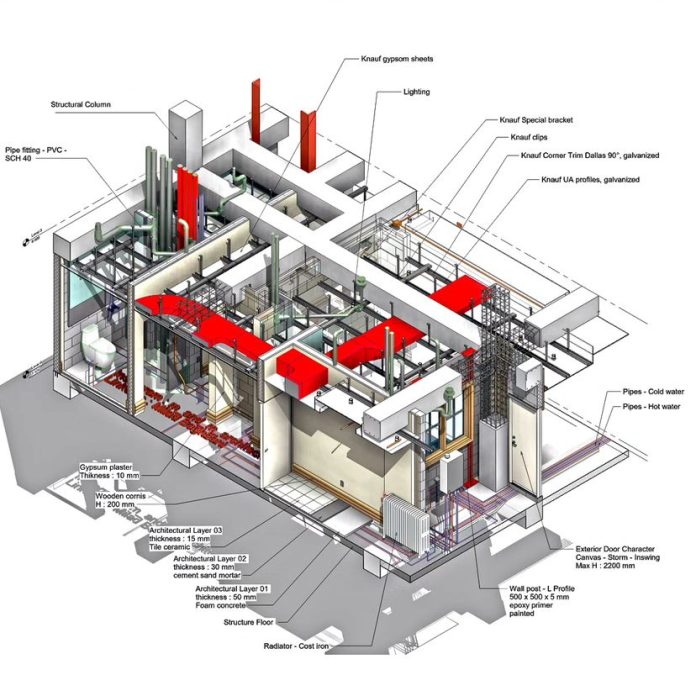Building Information Modelling (BIM) constitutes a structured methodology for the generation and administration of data about a building, infrastructure asset, or facility throughout its entire life cycle. The major outcome of this process is the Building Information Model (BIM), which serves as a digital representation of all the important features of the constructed entity.
This will usually involve the digital model of the architectural features, structural elements, electrical and mechanical services, etc. Notably, this model is progressively developed and refined through the collaborative incorporation and updating of information during the project’s execution. The prominent features of BIM in the construction industry are highlighted as follows;
- BIM as a Digital Repository: Building Information Modelling (BIM) leverages a digital model to serve as a comprehensive repository for data and information about a building, infrastructure, or facility throughout its entire lifecycle. This model necessitates continuous access, enrichment, and modification to maintain its accuracy and reflect project evolution.
- BIM as an Information Management Process: Beyond the digital model itself, BIM encompasses a structured process, or rather, a network of interconnected activities. This process focuses on managing the information embedded within these models to maximize their utility and optimize project outcomes.
- BIM-Driven Collaboration: A cornerstone principle of BIM is the emphasis on collaborative workflows. To ensure the information models remain current and usable, all stakeholders must engage in collaborative efforts at designated stages of the process, adhering to established protocols for data contribution and exchange.
Building Information Modeling (BIM) has revolutionized the construction industry, transforming how civil engineers approach design, construction, and project management. This technology fosters collaboration, optimizes workflows, and enhances decision-making throughout a project’s lifecycle. This article discusses the effects of BIM on civil engineering practices.

BIM vs. Traditional CAD
Traditionally, civil engineers relied on 2D drawings for design and communication. These drawings, while informative, often lacked the necessary depth and detail for comprehensive project visualization. BIM introduces a paradigm shift by creating intelligent 3D models involving all aspects of a civil engineering project. These models integrate architectural, structural, and MEP (Mechanical, Electrical, Plumbing) components, providing a holistic view of the infrastructure being designed.
Therefore, Building Information Modeling (BIM) fundamentally diverges from the conventional Computer-Aided Design (CAD) approach. This distinction lies in the concept of a singular source of truth. In BIM, all modifications are conducted directly on the central BIM model itself. As a consequence, individual plan derivations such as sections, views, and floor plans no longer necessitate independent updates when alterations are introduced.
The core distinction also manifests in the nature of the data being manipulated. BIM models are comprised of intelligent objects, imbued with semantic structure. These objects, representing elements like walls or slabs, transcend mere geometric representation. Conversely, CAD drawings solely depict geometry through interconnected lines and arcs, lacking the inherent intelligence of BIM objects.
The advantages of BIM in the construction industry extend well beyond the foundational concept of a centralized model. Well-established benefits, such as automated clash detection and code checking, are now widely recognized and employed within the industry. Additionally, visualization techniques leveraging Augmented Reality (AR) and Virtual Reality (VR) technologies are gaining traction, offering enhanced project understanding and communication.
Perhaps the most significant impact of BIM lies in its ability to foster exemplary collaboration amongst stakeholders involved in the design, construction, and operational phases of a project. As BIM workflows become increasingly integrated into standard practice, these well-known benefits are continuously being exploited and optimized, leading to significant improvements in project delivery.
BIM and Civil Engineers
Listed below are the benefits of BIM for civil engineers.
- Enhanced Collaboration: BIM facilitates seamless collaboration between civil engineers, architects, contractors, and other stakeholders. The 3D model serves as a central repository of information, enabling real-time communication and clash detection. This collaborative environment minimizes errors and omissions, leading to a more efficient design process.
- Improved Design Accuracy: BIM allows for the creation of highly detailed and accurate models, incorporating precise information about elements like roadways, bridges, utilities, and drainage systems. This approach reduces the likelihood of errors during construction, minimizing rework and associated costs.
- Optimized Project Management: BIM empowers civil engineers to leverage the data embedded within the 3D model for effective project management. The model allows for quantity takeoffs, cost estimation, and scheduling optimization. This data-driven approach fosters informed decision-making throughout the construction process.
- Enhanced Sustainability: BIM facilitates the evaluation of a project’s environmental impact during the design phase. The model allows for simulations to assess factors like material usage, energy consumption, and lifecycle costs. This enables civil engineers to design sustainable infrastructure that minimizes environmental footprint and optimizes resource utilization.
- Reduced Risk and Improved Safety: BIM facilitates clash detection, a process where potential conflicts between different design elements are identified within the 3D model. This proactive approach allows for early resolution of these conflicts, minimizing risks associated with rework and construction delays. Additionally, BIM can be used to simulate construction sequencing, promoting improved worker safety on-site.
BIM Applications in Civil Engineering
- Transportation Infrastructure: BIM plays a crucial role in the design and construction of roads, bridges, and tunnels. 3D models enable detailed analysis of traffic flow, structural integrity, and constructability.
- Water Resources Management: BIM facilitates the design of water treatment plants, dams, and irrigation systems. The 3D model allows for accurate modelling of water flow, hydraulic simulations, and construction sequencing.
- Site Development: BIM is instrumental in planning and designing site layouts, grading plans, and utility networks. The 3D model facilitates visualization of site constraints, underground infrastructure, and potential constructability challenges.
Challenges and the Road Ahead
Despite its immense benefits, BIM adoption in civil engineering faces challenges. These include the initial investment in software and training, the need for standardized data exchange formats, and the integration of BIM workflows with existing design practices. However, the construction industry is rapidly recognizing the transformative power of BIM. As technology advances, software becomes more user-friendly, and standardized data formats emerge, BIM is poised for even greater integration within civil engineering workflows.
Conclusion
BIM is no longer a novelty but a necessity for civil engineers in today’s competitive construction landscape. By embracing BIM, civil engineers can create efficient, sustainable, and cost-effective infrastructure projects while fostering a collaborative and data-driven approach to construction. As BIM continues to evolve, civil engineers will be at the forefront of shaping the future of the built environment.










